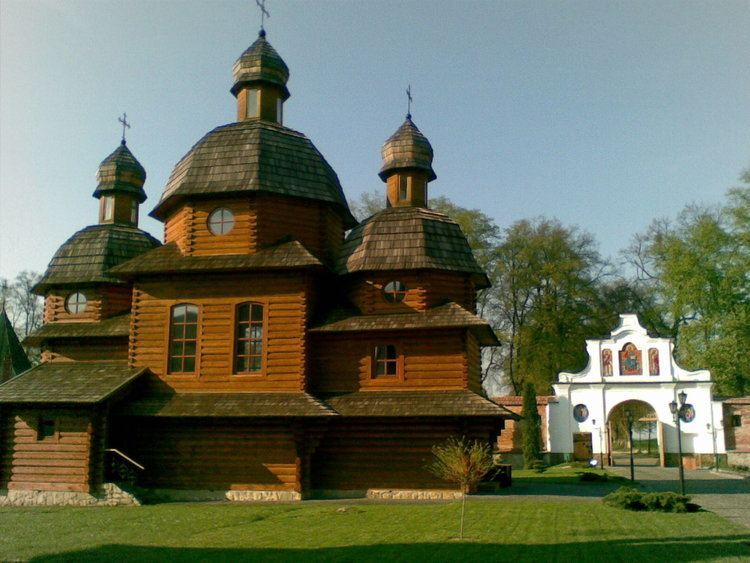Founded 1597 Postal code 80300—80304 Population 13,594 (2013) | City status 1603 Area code(s) +380 3252 Area 7.64 km² Local time Saturday 10:07 PM | |
 | ||
Weather 12°C, Wind SE at 8 km/h, 57% Humidity | ||
Zhovkva (Ukrainian: Жовква, [ˈʒɔu̯kwɑ]; Polish: Żółkiew; Yiddish: זאָלקוואַ; Russian: Жо́лква, 1951-1992: Нестеров, Nesterov) is a city in Lviv Oblast (region) of western Ukraine. It is the administrative center of Zhovkva Raion (district). Population: 13,594 (2013 est.).
Contents
Map of Zhovkva, Lvivska, Ukraine
History
The site of Zhovkva has been inhabited since the 14th century. Zhovkva was founded in 1594 as a private fortified town by the Polish nobleman Stanisław Żółkiewski, and, like Zamość, was built on an ideal Renaissance city plan. Due to its strategic location at the intersection of important trade routes, the town prospered.
In the 17th century, it became the royal residence for King John III Sobieski of Poland, and a hub of religious life, arts and commerce. From its earliest days, the population was a mix of Poles, Ukrainians and Jews. Landmark buildings include a fortress-like synagogue, churches and monasteries.
From the first partition of Poland in 1772 until 1918, the town (named Żółkiew) was part of the Austrian monarchy (Austria side after the compromise of 1867), head of the district with the same name, one of the 78 Bezirkshauptmannschaften in Austrian Galicia province (Crown land) in 1900.
The West Ukrainian People's Republic, established on November 1, 1918, included the whole Zhovkva povit (county), among many others. The fate of this territory was then disputed between Poland and Russia, until the Peace of Riga in 1921, attributing Galicia to the Second Polish Republic.
Before World War II, the town's 4,500 Jews accounted for nearly half the population, but few survived the Holocaust. The synagogue was blown up by the Nazis in 1941, leaving only the outside walls. In 2000, the building was declared one of the world's most endangered sites by the World Monuments Fund. A restoration campaign began in 2001, supported by WMF's Jewish Heritage Program and other sources, which is ongoing.
In 1939, following the Soviet invasion of Poland, Zhovkva, together with the rest of Poland's Kresy Wschodnie, was annexed by the Soviet Union and became a part of Ukrainian Soviet Socialist Republic in 1944. In 1951 the town was renamed Nesterov after the World War I aviator Pyotr Nesterov who became the first to perform aerial ramming in the history of aviation near Zhovkva in 1914. The name Zhovkva was restored in 1992, after Ukraine became independent of the Soviet Union.
Historical sites
The Collegiate Church of St. Lawrence, a domed church from the 17th century built by a group of Italian architects, was turned into a warehouse under Soviet rule. After Ukraine declared independence in the early 1990s, the church was restored.
The town center of Zhovkva was declared a heritage site in 1994, and restoration work is now under way. Zhovkva Castle, the town's oldest and largest building, is being converted into a culture and conference hall.
The wooden Holy Trinity Church built in 1720 was listed in 2013 as a World Heritage Site by UNESCO, as a part of the composite site Wooden tserkvas of the Carpathian region in Poland and Ukraine.
Relics of Saint Parthenius, 3rd-century Christian martyr from Rome were moved to Zhovkva in 1784. They are kept at the local Church of Holy Heart of Jesus, run by Ukrainian Greek-Catholic monks of the Basilian order.
Gas-free city
In 2017 Zhovkva became the first city of Ukraine that did not use gas in central heating system.
European Union financed Zhovkva project. It allowed to fully eliminate gas and use wood instead.
